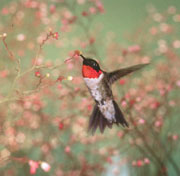Trouble in the World
Of Pollinators
By Kathy Reshetiloff
Imagine the world without
natural fibers, fruits, vegetables or flowers. That's what our
world would be like without pollinators, insects and other animals
that pollinate our plants. Two-thirds of our flowering plants
are pollinated by insects, birds or bats, and more than three-fourths
of the world's crops rely on insects and other animals for pollination.
The global economic benefit of pollination has been estimated
at $117 billion.
 Pollination is critical to successful orchards, field crops, forage
crops, home gardens, endangered species protection and ecological
restoration. As food producers and consumers, we all need to be
aware of the importance of pollinators to plants and to our environment.
Pollination is critical to successful orchards, field crops, forage
crops, home gardens, endangered species protection and ecological
restoration. As food producers and consumers, we all need to be
aware of the importance of pollinators to plants and to our environment.
Most plants need to make seeds in order to reproduce. But many
can't do it by themselves. To make seeds, the female part of the
plant, called a pistil, needs pollen from the male part of the
flower, called a stamen. Cross-pollination is the rule of thumb
in the plant world. This means not only does pollen have to be
transported from stamen to pistil but it also must come from separate
flowers. Some plants rely on the wind to do this. Many others
depend on animals. Pollinators move pollen from one flower to
another so that the receiving plant can make seeds and reproduce.
As they gather nectar from flowers, insects, like bees, get sticky
pollen grains on their bodies. By moving from one flower to another,
bees transfer pollen to the pistils. Bees aren't the only pollinators
though. Other insects, like wasps, flies, butterflies, moths and
beetles are important pollinators. Larger animals, like birds
(especially hummingbirds), flying foxes, bats, possums, lemurs,
rodents and even a gecko, help move pollen.
Plants need pollinators and vice versa. This co-dependence is
exhibited in many ways. Many night-pollinated flowers close during
the day, to prevent thieves from getting at their nectar and pollen.
On the other hand, many daytime-pollinated flowers close at night
for the same reason. Flowers pollinated at night are usually white
or pale yellow and very fragrant. This helps announce the flowers'
presence. Darker-colored flowers, not as visible at night, are
usually pollinated by day-flying insects.
Flowers assist the pollinator in finding where the pollen or nectar
is stored. Flowers often have bee lines, dots or color variations
that direct the pollinator. Flowers have many shapes: bowl, cup,
star or tube. Shapes are specific to pollinators and, in some
cases, also keep out unwanted pollen collectors.
Some insects, like ants, love nectar but are not good pollinators.
Plants have developed protective devices, like closed throats
or sticky hairs, designed to keep ants and other robbers out.
Other plants exude a sweet liquid on their stem to sidetrack unwanted
visitors. Hiding nectar in tubes and closed blossoms has many
advantages. If it the nectar is hard to get, usually only designated
pollinators can find it.
Despite their importance to our economy and our lives, many pollinators
are in trouble. Honeybees, raised specifically to pollinate crops,
are in decline. One quarter of all managed hives have been lost
since 1990 mainly due to parasitic mites, disease pesticide poisoning
and climate fluctuations. Wild pollinators are also disappearing
at alarming rates due to habitat loss, pesticide poisoning, diseases
and pests.
A healthy ecosystem provides pollinators with habitat for foraging,
nesting, roosting and mating. Homes, businesses and roads are
replacing the native fields, wetlands and forests that are home
to many pollinators. In addition, many of the wildflowers that
pollinators feed on are rapidly disappearing.
Pesticides are also a threat. Many pesticides used on farms and
backyard gardens are broad-spectrum types, meaning they can harm
non-target species too. Many insecticides that get rid of plant
pests are toxic to bees and other beneficial insects.
Pollinators such as bats, butterflies and hummingbirds face even
more problems. They may migrate many miles over the course of
a year. These travelers need nectar-producing flowers all along
their journeys. But wildflowers and natural habitats are being
replaced by development. Less food and habitat is available to
pollinators as they migrate. Migrating pollinators have to deal
with additional threats such as automobiles and pesticides use.
There are many things each of us can do to help pollinators.
Reduce the use of pesticides or, if possible, stop using them
altogether. If you must use an insecticide, apply it in the evening
when many pollinators are inactive.
Plant gardens filled with nectar-producing flowers that are native
to (grow naturally in) your area.
Leave tree stumps, dead branches, and rotting trees on your property,
if possible. They provide nests for some species of bees. Provide
other nesting sites for birds, bats, butterflies, bees and other
insects.
If you find a bee nest too close to your home, don't destroy it.
Contact a local beekeeper or your state cooperative extension
service for advice about removing the nest without harming the
bees.
Restore or enhance wildlife habitat on your land. Contact the
U.S. Fish and Wildlife Service's Chesapeake Bay Field Office at
(410) 573-4500 or visit our website www.fws.gov/r5cbfo/
or contact your state wildlife department for more information.
Kathy Reshetiloff is employed by the U.S. Fish and Wildlife Service, U.S. Department of the Interior. Photo by Steve Maslowski, U.S. Fish and Wildlife Service.
|
Back
|

